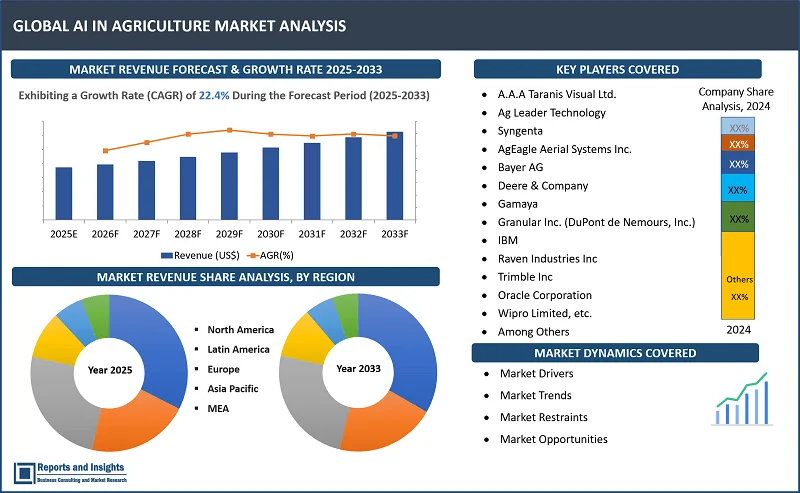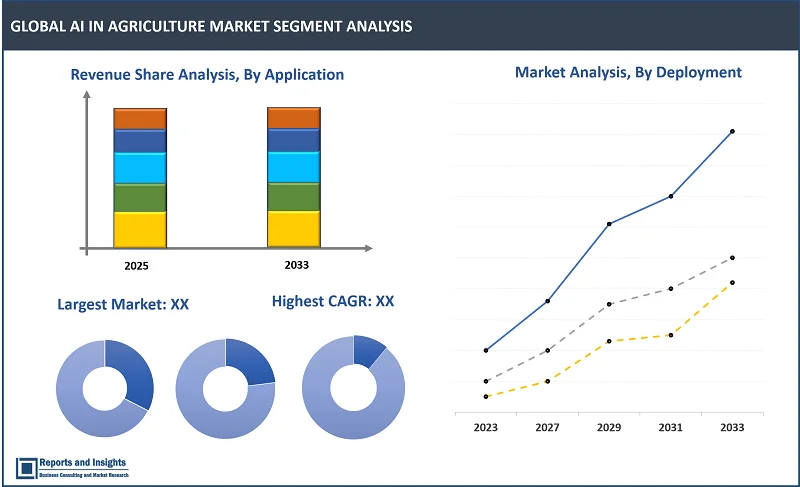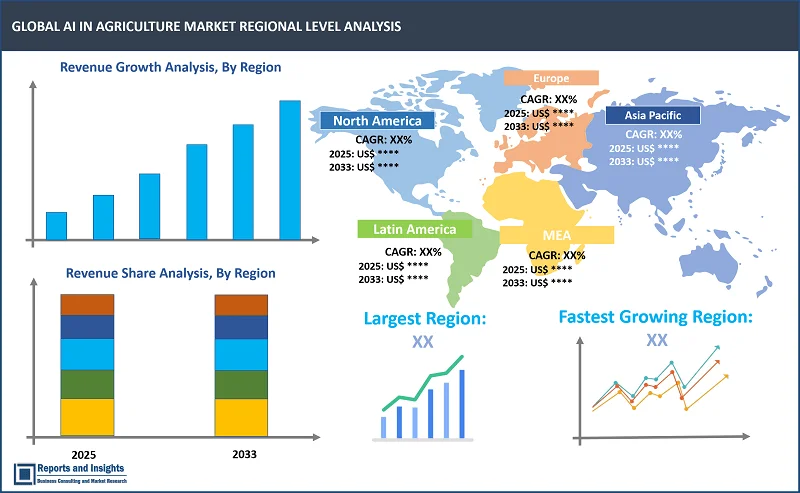Market Overview:
"The global AI in agriculture market was valued at US$ 2.1 Billion in 2024 and is expected to register a CAGR of 22.4% over the forecast period and reach US$ 12.9 Billion in 2033."
|
Report Attributes |
Details |
|
Base Year |
2024 |
|
Forecast Years |
2025-2033 |
|
Historical Years |
2021-2023 |
|
Market Growth Rate (2025-2033) |
22.4% |
AI in agriculture entails using sophisticated computational technologies, machine learning, and data analytics to enhance and streamline farming practices. By analyzing vast agricultural data, AI provides valuable insights into crop health, yield predictions, and optimal resource allocation. Precision farming methods driven by AI enable farmers to make informed decisions, optimize resource usage, and automate tasks such as planting and pest control. This integration not only boosts operational efficiency but also encourages sustainable farming practices, leading to better yields and increased resilience against agricultural challenges.
The market for AI in agriculture is experiencing rapid growth, fueled by the widespread adoption of precision farming methods. AI technologies such as machine learning, computer vision, and data analytics are transforming conventional agricultural approaches. These advancements empower farmers to make informed decisions, enhance resource utilization, and boost crop yields. Additionally, increasing demand for agricultural drones, automated machinery, and IoT devices is driving market expansion by further improving farm efficiency and productivity. With the global population on the rise, AI in agriculture is poised to play a vital role in ensuring food security and promoting sustainable farming practices.

AI in Agriculture Market Trends and Drivers:
The AI in agriculture market is experiencing substantial growth, driven by significant trends and factors. Farmers are increasingly adopting advanced technologies such as machine learning and predictive analytics to optimize crop monitoring, precision farming, and decision-making. AI enables thorough analysis of vast agricultural data, leading to improved resource utilization, accurate crop yield predictions, and effective disease detection. Integration of drones, sensors, and IoT devices further enhances these capabilities, offering a comprehensive and interconnected approach to modern agriculture. Rising awareness of the benefits of data-driven decision-making is boosting demand for AI solutions in farming. Collaborations between technology firms and agricultural stakeholders are driving innovation, ushering in a transformative phase for the AI in agriculture market characterized by sustainability and increased productivity.
AI in Agriculture Restraining Factors:
Despite the positive growth prospects, the AI in Agriculture market faces several challenges. A significant barrier is the high initial costs associated with implementing AI technologies, including purchasing advanced equipment and providing extensive training. Concerns about data privacy and security also hinder widespread acceptance, as farmers are hesitant to share confidential agricultural information. The lack of standardized regulations and difficulties in integrating various AI solutions further complicate adoption efforts. Additionally, the digital divide in rural areas, where access to technology is limited, slows down the adoption rate. These factors create a complex landscape that requires strategic solutions to fully leverage the potential of AI in agriculture.
AI in Agriculture Market Opportunities:
The AI in Agriculture market is brimming with opportunities for growth and advancement. With a burgeoning global population and escalating food demand, there is a pressing need for enhanced agricultural efficiency, creating a fertile ground for AI adoption. AI technologies in precision farming offer the potential to optimize resource utilization, diminish environmental impact, and increase crop yields. Moreover, integrating AI into crop monitoring, disease detection, and predictive analytics presents avenues for sustainable and well-informed decision-making in agriculture. Collaborative endeavors between technology providers and agricultural stakeholders can facilitate the development of tailored AI solutions, paving the way for customized applications that cater to diverse farming needs. As AI continues to evolve, the industry stands poised to surmount challenges and revolutionize traditional farming practices, propelling towards a more resilient, productive, and sustainable future.
AI in Agriculture Market Segmentation:

By Component
- Solution
- Service
The component segment is categorised into solution and service. Among these components, solutions are currently dominating the AI in agriculture market. This is because solutions encompass the technological frameworks, software applications, and AI tools that are directly applied to enhance agricultural processes, such as crop monitoring and predictive analytics. These solutions offer farmers advanced capabilities to optimize resource use, improve decision-making, and increase productivity, making them a significant driver of growth and innovation in the AI in agriculture market.
By Application
- Crop and Soil Monitoring
- Livestock Health Monitoring
- Intelligent Spraying
- Precision Farming
- Industrial Robot
- Weather Data and Forecast
The application segment is categorised into crop and soil monitoring, livestock health monitoring, intelligent spraying, precision farming, industrial robot, and weather data and forecast. Among these, precision farming is the leading application in the AI in agriculture market. It involves using technology to enhance agricultural practices like planting, irrigation, and fertilization based on data-driven insights. This method helps farmers maximize yields, reduce inputs, and minimize environmental impact. Precision farming is a key driver of the adoption of AI technologies in agriculture.
By Deployment
- Cloud
- On-premises
- Hybrid
The deployment segment is categorised into cloud, on-premises, and hybrid. Among these, cloud deployment is currently dominating in the AI in agriculture market. It provides scalability, flexibility, and accessibility, allowing agricultural organizations to access and use AI technologies easily without requiring extensive on-site infrastructure. This model is especially advantageous for AI applications in agriculture because it enables real-time data processing, analysis, and collaboration among stakeholders.
By Region

North America
- United States
- Canada
Europe
- Germany
- United Kingdom
- France
- Italy
- Spain
- Russia
- Poland
- Benelux
- Nordic
- Rest of Europe
Asia Pacific
- China
- Japan
- India
- South Korea
- ASEAN
- Australia & New Zealand
- Rest of Asia Pacific
Latin America
- Brazil
- Mexico
- Argentina
Middle East & Africa
- Saudi Arabia
- South Africa
- United Arab Emirates
- Israel
- Rest of MEA
Leading AI in Agriculture Providers & Competitive Landscape:
The AI in agriculture market is highly competitive, with several key players vying for market share and actively engaging in strategic initiatives. These companies focus on product innovation, technological advancements, and expanding their product portfolios to gain a competitive edge. These companies are continuously investing in research and development activities to enhance their product offerings and cater to the evolving needs of customers in terms of efficiency, performance, and sustainability.
These companies include:
- A.A.A Taranis Visual Ltd.
- Ag Leader Technology
- AgEagle Aerial Systems Inc.
- Bayer AG
- Deere & Company
- Gamaya
- Granular Inc. (DuPont de Nemours, Inc.)
- International Business Machines Corporation
- Raven Industries Inc
- Trimble Inc
- Oracle Corporation
- Wipro Limited, etc.
AI in Agriculture Market Recent Development:
- September 2024: Syngenta Group, a leading global agricultural innovation company, recently unveiled its latest development, Cropwise AI. This technology, launched at the World AgriTech Innovation Summit in London, is expected to revolutionize agricultural practices through innovative artificial intelligence capabilities.
- July 2024: Google launched AI-powered agricultural information tool, designed to provide farmers with valuable insights and recommendations for drought preparedness and irrigation. By leveraging advanced AI and machine learning techniques, the tool can analyze large amounts of agricultural data, weather patterns, and soil conditions to offer actionable, targeted advice to farmers to reduce their crop loss.
AI in Agriculture Market Research Scope
|
Report Metric |
Report Details |
|
AI in Agriculture Market Size available for the years |
2021-2033 |
|
Base Year |
2024 |
|
Forecast Period |
2025-2033 |
|
Compound Annual Growth Rate (CAGR) |
22.4% |
|
Segment covered |
Component, deployment, application, and regions. |
|
Regions Covered |
North America: The U.S. & Canada Latin America: Brazil, Mexico, Argentina, & Rest of Latin America aAsia Pacific: China, India, Japan, Australia & New Zealand, ASEAN, & Rest of Asia Pacific Europe: Germany, The U.K., France, Spain, Italy, Russia, Poland, BENELUX, NORDIC, & Rest of Europe The Middle East & Africa: Saudi Arabia, United Arab Emirates, South Africa, Egypt, Israel, and Rest of MEA |
|
Fastest Growing Country in Europe |
Germany |
|
Largest Market |
North America |
|
Key Players |
A.A.A Taranis Visual Ltd., Ag Leader Technology, AgEagle Aerial Systems Inc., Bayer AG, Deere & Company, Gamaya, Granular Inc. (DuPont de Nemours, Inc.), International Business Machines Corporation, Raven Industries Inc, Trimble Inc, Oracle Corporation and Wipro Limited, etc. |
Frequently Asked Question
What is the size of the global AI in agriculture market in 2024?
The global AI in agriculture market size reached US$ 2.1 Billion in 2024.
At what CAGR will the global AI in agriculture market expand?
The global AI in agriculture market is expected to register a 22.4% CAGR through 2025-2033.
How big can the global AI in agriculture market be by 2033?
The market is estimated to reach US$ 12.9 Billion by 2033.
How is the global AI in agriculture market report segmented?
The global AI in agriculture market report segmentation is based on component, deployment, application, and regions.
Who are the leading key players in AI in agriculture market?
A.A.A Taranis Visual Ltd., Ag Leader Technology, AgEagle Aerial Systems Inc., Bayer AG, Deere & Company, Gamaya, Granular Inc. (DuPont de Nemours, Inc.), International Business Machines Corporation, Raven Industries Inc, Trimble Inc, Oracle Corporation and Wipro Limited, etc.
What arе somе of the major restraints for global AI in agriculture markеt?
High initial costs associated with implementing AI technologies and data privacy and security arе somе of the major restraints for global AI in agriculture markеt.
How is thе compеtitivе landscapе in thе global AI in agriculture markеt?
Thе compеtitivе landscapе in thе global AI in agriculture markеt is fragmеntеd, with sеvеral dominant playеrs.
What region is expected to dominate the market during the forecast period?
North America region is expected to dominate the market during the forecast period.

